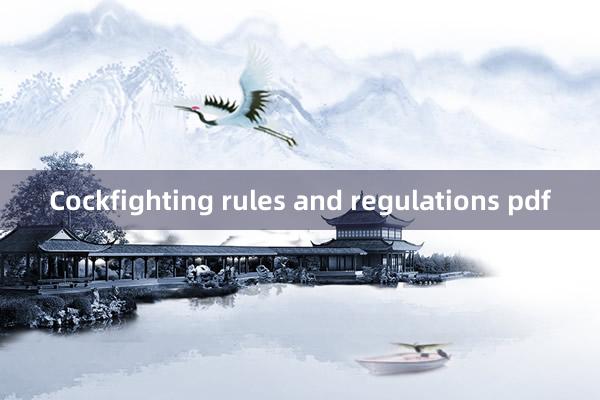
Cockfighting is an ancient practice that dates back centuries, with cultural significance in various parts of the world. However, its status in modern society is highly controversial, and many countries have imposed strict rules and regulations surrounding the activity. For those who seek to understand the legal aspects of cockfighting, obtaining a comprehensive guide in the form of a "Cockfighting Rules and Regulations" PDF is an essential step. This article will explore the key legal frameworks, ethical considerations, and safety measures that govern cockfighting in regions where it remains legal, while also highlighting its status in countries where it is banned.
The legal status of cockfighting varies greatly across the world. In many countries, the practice is strictly prohibited, while in others, it is allowed but heavily regulated. In countries like the United States, cockfighting is illegal in all 50 states, and there are federal laws in place that prohibit activities related to cockfighting, such as transporting birds across state lines for the purpose of fighting. The Animal Welfare Act (AWA) is a key piece of legislation in the U.S. that makes it illegal to sponsor or exhibit animals in any fighting ventures.
In contrast, some countries, particularly in parts of Asia and Latin America, allow cockfighting to take place within regulated environments. For instance, in the Philippines, cockfighting is deeply ingrained in the culture and is allowed under specific conditions. Local authorities regulate these events, ensuring that they follow designated safety and fairness rules, often requiring event organizers to acquire special licenses.
In regions where cockfighting remains legal, bongdalu fun authorities typically impose a set of rules and regulations to ensure that the events are carried out in an orderly fashion. These rules often pertain to both the treatment of the birds and the conduct of the matches themselves.
Registration and Licensing
In areas where cockfighting is regulated,
bw777 organizers are generally required to obtain a license from the government or a governing body. This process usually involves registering the event and ensuring that the venue meets specific safety standards. Without proper licensing,200jili the event can be shut down, and fines or legal penalties may be imposed.
Health and Safety of the Roosters
Another common regulation involves the health and safety of the birds used in fights. In many places, there are strict veterinary checks that the birds must pass before being allowed to participate. This is intended to prevent the spread of diseases and ensure that the birds are in proper physical condition.
Banning of Performance-Enhancing Substances
Similar to regulations in human sports, cockfighting rules often prohibit the use of performance-enhancing drugs or substances. Any rooster found to have been given illegal stimulants may be disqualified, and the owner may face penalties.
Fairness in Fighting Conditions
Regulations often require that both birds be of similar size, weight, and condition to ensure a fair match. This rule is designed to avoid one-sided battles where one rooster has an unfair advantage over the other.
Weaponry
In legal cockfighting arenas, the use of artificial spurs or knives attached to the roosters' legs is often allowed but regulated. These weapons are typically crafted according to strict specifications to avoid unnecessary cruelty. Some regions, however, completely ban such weapons due to ethical concerns.
Despite its legality in some parts of the world, cockfighting faces significant opposition from animal rights groups and concerned citizens who view it as inhumane. These critics argue that the practice subjects animals to needless suffering, often resulting in severe injuries or death for the roosters involved. Organizations such as PETA (People for the Ethical Treatment of Animals) and the ASPCA (American Society for the Prevention of Cruelty to Animals) have long campaigned against cockfighting, citing its cruelty and the inherent suffering involved in forcing animals to fight.
In regions where cockfighting is banned, these ethical concerns have played a significant role in shaping legislation. Many countries, including the U.K., Canada, and Australia, have outlawed cockfighting entirely, with heavy fines and jail time imposed on those caught organizing or participating in these events. Additionally, the public's changing attitudes toward animal welfare have led to stricter enforcement of laws that prohibit cockfighting.
For many people, especially in regions where cockfighting remains legal, the practice is seen not just as a sport but as a cultural tradition. In the Philippines, for example, cockfighting, or "sabong," is a time-honored tradition that plays a central role in local festivities and gatherings. Proponents of cockfighting often argue that the sport is an integral part of their heritage and should be preserved, albeit with strict regulations in place to ensure the safety and well-being of the animals.
Cockfighting is a practice steeped in history and tradition, but its place in modern society is highly debated. In countries where it remains legal, the activity is regulated through a set of rules and guidelines designed to ensure fairness and minimize harm to the animals involved. However, in many parts of the world, cockfighting is illegal due to concerns over animal cruelty and ethical considerations. Whether you are a researcher, a policy maker, or simply someone looking to understand more about the subject, obtaining a "Cockfighting Rules and Regulations" PDF can provide valuable insight into the laws governing this controversial activity. Understanding the legal framework is essential for anyone involved in or studying the practice, ensuring that it is carried out, if at all, in accordance with the law.
JILI games APKwww.supremaa.com